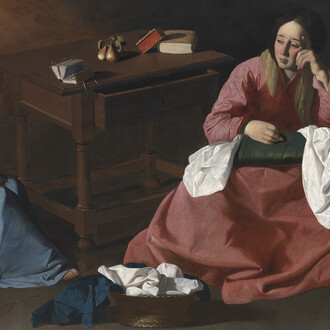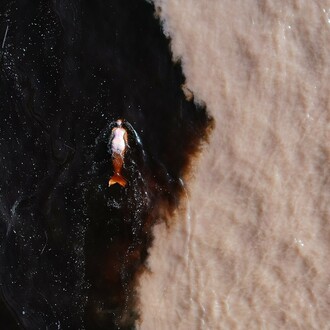Hales is delighted to announce Family album, a solo exhibition by Guyanese-British artist Hew Locke. The artist’s sixth solo show with the gallery brings together new and historical works, highlighting a key arc of exploration in Locke’s practice — the iconography of royalty. Throughout his career Locke has been concerned with symbolic embodiments of power and empire, displayed in this show through two key bodies of work spanning across two decades – The house of windsor and Souvenirs. The exhibition at Hales coincides with Locke’s show What have we here?, opening at the British Museum on the 17th of October 2024, and precedes his expansive survey exhibition at the Yale Center for British Art (Connecticut, USA), opening in autumn 2025.
Locke (b.1959 Edinburgh, Scotland) spent his formative years in Guyana before returning to the UK to study Fine Art at Falmouth (1988) followed by an MA in Sculpture at the Royal College of Art (1994). He was elected a member of the Royal Academy of Arts in 2022 and was awarded an OBE for Services to Art in 2023. Locke lives and works in London. Growing up in Georgetown, Guyana, which was newly independent, colonial remnants remained prominently present in everyday life on school textbooks, as public statues and old coinage. This early experience stayed with the artist, who continues to make depictions of the royal family.
The exhibition at Hales is anchored by five monumental royal portraits from The house of windsor series – a renowned body of work which includes cardboard portraits, sculptural heads as well as smaller scale drawings and watercolours. These detailed cardboard heads are imposing, intricately patterned, hand cut, using a knife like a pen, then monochromatically painted. Iconic, the royal family are one of the most recognisable symbols of British identity. Locke draws attention to these subjects with humour and a sense of the outlandish, illuminating both history and contemporary relevance with nuance, while also leaving interpretation open-ended. Curator Kris Kuramitsu notes that in The house of windsor, ‘Locke renders them [the royal family] with a lavish attention that denies a simple negative reading’1.
Cardboard has featured prominently in Locke’s oeuvre, as he uses this common packing material to speak to global trade and commodification. From portraits to complex architectural structures, cardboard accented with white paint and black marker pen is synonymous with the artist. Locke’s use of materials, elevating the cheap and ubiquitous to something magnificent, has become his personal language. Hemmed in two (2000), a complex cardboard structure, part boat, part caravanserai, part fairground ride, was once installed in the Victoria and Albert Museum and is now in the collection of the Perez Art Museum Miami. Cardboard palace (2002), another large-scale installation created for an exhibition at the Chisenhale Gallery in London, was an expansive series of architectural rooms through which you walked, featuring images of royalty. More recently Locke has created figures incorporating cardboard for his significant commission The procession at Tate Britain (2022), which toured to the Baltic Centre for Contemporary Art in Gateshead and the ICA Boston, Massachusetts. Similar figures The watchers also feature in his show at the British Museum (2024), which includes new works interacting with pieces from their permanent collection.
Alongside historical works from the House of windsor series are several new sculptures by Locke from his ongoing and internationally renowned body of work titled Souvenirs. Originally started in 2018, Souvenirs are antique Parian ware busts of royalty adorned with various regalia. They have been exhibited in Locke’s solo exhibition at Ikon Gallery, Birmingham Here’s the thing (2018), group show Life between islands, Tate Britain (2021/2022) and are in the collections of the V&A Museum, Birmingham Museum and Art Gallery and the Baltimore Museum of Art, among others.
In new Souvenirs made for the show, Locke continues to explore complex relationships to nationhood. He has exquisitely masked the royal busts with opulent crests, crowns, talismans, trade-beads, memento mori and military insignia. The burden of colonial history is conveyed through physically weighing down each sovereign. However, while enticingly glittering and gold, on closer inspection the regalia is revealed to be brass or plastic. Locke has used this approach to a varying degree in many of his works: from Souvenirs and public sculpture (such as his project for the 2022 Commonwealth Games, which saw him reimagine Birmingham’s famous statue of Queen Victoria) to his ongoing series of boat sculptures such as Armada (Tate collection) and Cui nono? (collection of Kunsthalle Bremen), in which the boat is used as a potent symbol of warfare, trade and culture. Family album sees Locke bring together all these areas of interest in a new sculpture, in which a smaller scale version of Birmingham centre’s statue of Queen Victoria is placed on a boat loaded with cargo.
Family album brings together works in which Locke explores generations of royalty through different depictions to encourage a greater understanding of iconography. Contributing to the current conversation regarding complex legacies, instead of ignoring or destroying parts of the past, Locke transforms portraits and statues in order to reveal and recontextualise them.
Locke's work is represented in many collections including Tate, UK; Victoria & Albert Museum, UK; the British Museum, UK; the Arts Council, UK; Government Art Collection, UK; the New Art Gallery, Walsall, UK; the Henry Moore Institute, UK; the Metropolitan Museum of Art, NY, USA; the Brooklyn Museum, NY, USA; Perez Art Museum Miami, FL, USA; the Kemper Museum of Contemporary Art, USA; Kansas City Collection, USA; the RISD Museum, RI, USA; Santa Barbara Museum of Art, CA, USA; Queensland Art Gallery (QAGoMA), Australia; Kunsthalle Bremen, Germany and many more.
Locke’s recent commissions include Gilt at the Metropolitan Museum of Art NY (2022) and Procession for the Duveen Gallery, Tate Britain (2022), which toured to the Baltic Centre for Contemporary Art, Gateshead (2023) and the ICA Boston, Massachusetts (2024). Locke’s major show, Here’s the thing at IKON gallery in Birmingham (2019) toured to Kemper Museum of Contemporary Art, Kansas City, Missouri, USA (2019/2020) and Colby College Museum of Art, Maine, USA (2020).
Selected solo shows and presentations include the Imperial War Museum, London, UK; Victoria & Albert Museum, London, UK; the New Art Gallery, Walsall, UK; Prospect.3, New Orleans, LA, USA; the Luckman Fine Arts Complex, LA, USA; Atlanta Contemporary Art Center, GA, USA; Chisenhale Gallery, London, UK; The Rathaus, Bremen, Germany; and Kochi-Murziris Biennial, India.
Selected group shows include Tate Britain, London, UK; National Portrait Gallery, London, UK; the British Museum, London, UK; the New York Museum of Art and Design, NY, USA; Brooklyn Museum, NY, USA; Studio Museum, Harlem, New York, USA; The Met Breuer, New York, USA; the Bell House, Prague, Czech Republic; Kunsthal KAdE, Amersfoort, Netherlands; National Gallery of Singapore; and Hangzhou Triennial of Fiber Art, China.
Notes
1 Hew Locke, Cornerhouse Publications: Manchester, 2005, p4.
















